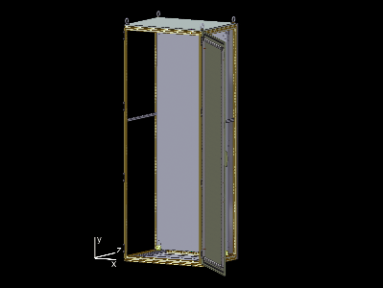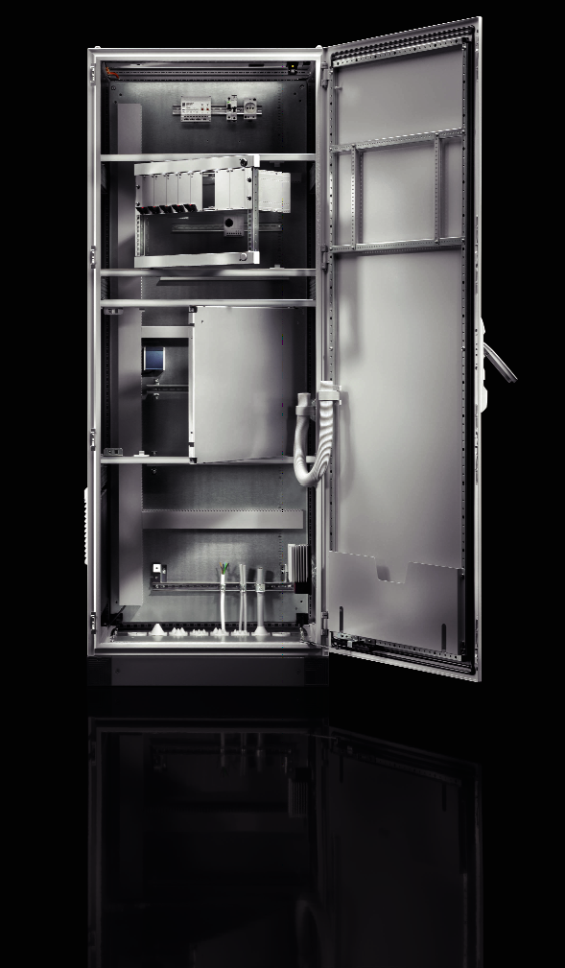 Rittal’s John Wilkins explains how the company’s new offerings are providing configuration diversity and significant cost advantages within increasingly complex industrial applications
Rittal’s John Wilkins explains how the company’s new offerings are providing configuration diversity and significant cost advantages within increasingly complex industrial applications
The demand for a standardised enclosure system infrastructure that can be assembled efficiently is growing, in line with the complexity of industrial applications, as all industry sectors are increasingly under pressure to keep the costs of engineering and handling in check.
Free standing enclosures are used in many areas of industry and building services management. Typical fields of application are in very compact machinery and equipment, whose power distribution and automation components can be accommodated in one single enclosure.
Rittal has introduced its new SE 8 system enclosure, a one piece monobloc, single construction floor standing enclosure, with an integrated TS 8 frame, which provides configuration diversity and cost advantages in one product. Unlike baying suites with frames and removable side panels, the body consists of two side panels and a roof and is made from one piece of sheet steel.
What does this mean for the user?
This means that both handling and the installation of separate side panels are eliminated. The SE 8 has a removable rear panel, which is secured from the inside and shares many design features with Rittal’s TS 8 bayable enclosure.
Standardised solutions play an ever increasing role and offer tangible benefits for plant constructors who can react to very different requirements quickly and safely thanks to a common platform and a well stocked modular system.
An enclosure’s potential efficiency primarily depends on interaction with an extensive range of accessories. Because of the TS 8 sections on the side panels, the user can quickly install the complete range of accessories familiar from the baying system in the SE 8. The accessories include virtually all the products needed in enclosure configuration ranging from enclosure lights through to climate control solutions.
Overall, the user also benefits from the improved interior installation capabilities. Flexibility and additional space are provided by expanding on two mounting levels. Integration on a unified system platform offers significant advantages. In the past, a customer who used both free standing enclosures and bayed enclosure suites always had to provide different accessories for both versions. Now, the variety of parts held in stock can be greatly reduced.
 Constructional improvements
Constructional improvements
Integration in the system platform results in logistical advantages, but there are also constructional improvements compared to the predecessor. For example, automatic potential equalisation of the enclosure body with rear panel and gland plates has been implemented in the new free standing enclosure.
This is achieved by using special contact elements pushed into the surface coating during the assembly procedure, establishing a secure electrical connection. Attaching separate earthing straps, which is still necessary with most enclosures presently on the market, is now a thing of the past. During installation, the assembly time per enclosure (not including the time saved by the absence of earth straps) is greatly reduced, leading to corresponding cost reductions.
Integrating the SE 8 free standing enclosure in the system platform also presents new opportunities during the planning phase. Up to now, users first had to specify one type of enclosure before they could begin planning. Since the interior installation of Rittal’s baying systems and free standing enclosures are completely identical, the user can already begin to plan, only defining whether a free standing or a bayed enclosure makes sense for the specific application at a later stage. This increases flexibility – if, for instance, it becomes apparent during planning that the free standing enclosure is insufficient, the same solution can simply be used for the TS 8 and expanded accordingly.
The flexibility required for free standing enclosures also relates to the base/plinth. Normal assembly time for a sheet steel base used to be about ten minutes, due to the need to attach small parts with screws. The Flex-Block base system, made from plastic corner modules and launched by Rittal last year, is an alternative to steel plinths and offers tool-free installation of all base components that merely takes one minute.
Summary
Improvements that have now been incorporated in the base/plinth concept mean more benefits for the user through the use of even fewer parts, faster assembly and more options for interior installation. The biggest change involves the panels – they have been replaced by a new sheet steel version which, at the same time, stabilises the existing mounting rails.
These rails still form part of the accessories, because they permit interior installation on two mounting levels. This increases flexibility and frees-up additional space. They also form the basis for cable clamp rails. The four fully symmetrical corner modules made of plastic, with drilled holes for the adapter sleeves to accommodate levelling feet and twin castors, remain unchanged.
Rittal
T: 01709 704 000

